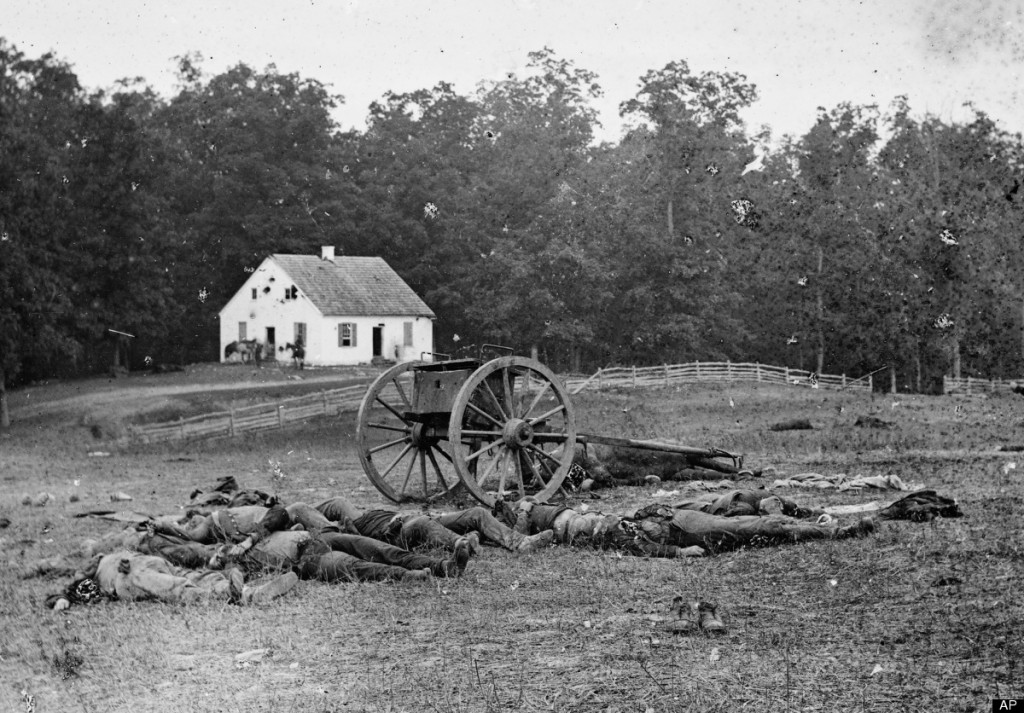All CLEP Humanities Resources
Example Questions
Example Question #211 : Renaissance To Contemporary 2 D Art

The above photography was made by which notable American artist?
Matthew Brady
Alfred Stieglitz
William Page
Willard Van Dyke
Ansel Adams
Matthew Brady
The work of Matthew Brady during the American Civil War pioneered many notable aspects of photography, which was still a new medium and had mostly been devoted to portraiture. Brady's willingness to document the Civil War by going to battlefields reframed the possibilities for photography, notably allowing for the development of photojournalism.
Example Question #2 : Identifying Artists, Works, And Schools Of 2 D Visual Art
Who was the painter who chronicled the wildlife, particularly birds, of nineteenth century America?
John Singer Sargent
Gilbert Stuart
Frederic Remington
James Carroll Beckwith
John James Audubon
John James Audubon
John James Audubon was a Frenchman who came to America in 1803 to avoid the Napoleonic Wars. He made a name for himself in the early nineteenth century as a painter of wildlife and landscapes of the then vast American frontier. His The Birds of America, published in sections between 1827 and 1838, not only was a remarkable work of art by an American artist, but helped ornithology immensely in understanding avian wildlife in America.
Example Question #3 : Identifying Artists, Works, And Schools Of 2 D Visual Art
The artistic movement known as Impressionism began in which country?
England
France
Italy
The Netherlands
Spain
France
Impressionism grew popular in the nineteenth century as a reaction to France's main artistic competition, the Salon de Paris. The Salon's judges valued grand themes, realistic portrayals, and fine brushwork, whereas the Impressionists focused on everyday scenes, emotional depictions, and visible, thick brushstrokes. Some of the major impressionists include Paul Cézanne, Édouard Manet, Pierre-Auguste Renoir, and Claude Monet.
Example Question #271 : 2 D Art
Which of the following grouping of artists were NOT part of the same art movement?
Paul Cézanne, Édouard Manet, Claude Monet
Pablo Picasso, Georges Braque, Fernand Léger
Jackson Pollock, Wassily Kandinsky, Mark Rothko
Jasper Johns, Robert Rauschenberg, Roy Lichtenstein
Vincent van Gogh, Henri Matisse, Joan Miro
Vincent van Gogh, Henri Matisse, Joan Miro
Vincent van Gogh, Henri Matisse, and Joan Miró were all connected as artists through their use of color and experimentation with forms. Nonetheless, each artist developed his own unique style that largely stood apart from other artists. Van Gogh's postimpressionistic style built on impressionism, while Matisse and Miro's deconstruction of form and representation exploded many of impressionism's notions of art.
Example Question #431 : Clep: Humanities
Which American artist is well-known for his paintings and sculptures of the American West?
Thomas Moran
John Singer Sargent
Frederic Remington
Ansel Adams
James Abbott McNeill Whistler
Frederic Remington
Frederic Remington was a native New Yorker who began his career as a painter and illustrator for magazines after the Civil War. After going on assignment to illustrate a magazine article on the Apache leader Geronimo in 1886, Remington began to paint and sculpt images of the American West exclusively. Remington's style was naturalistic and empathetic to his subjects, and also had a natural ability to capture accurate movement. Remington's images of the Old West are some of the most famous images of cowboys and Native Americans.
Example Question #31 : Identifying Artists, Works, Or Schools Of Nineteenth Century 2 D Art
Gustave Courbet is well known for developing and working in what style?
Impressionism
Expressionism
History painting
Realism
Romanticism
Realism
Gustave Courbet (1819-1877) was a French painter who reacted to the previous generation's bold romanticism and his contemporary critics' love of history painting by developing what he termed "realism." Courbet wished to use his painting to comment on social issues and values, which he felt were valuable topics on which a painter might focus. Courbet sought out landscapes, portraits, and still lifes that depicted the everyday in rough, honest brushstrokes.
Example Question #271 : 2 D Art
Who of the following artists was known for his "orientalist" paintings?
Eugene Delacroix
Claude Monet
Paul Gauguin
Georges Seurat
Edgar Degas
Eugene Delacroix
Delacroix was a famous nineteenth-century painter known for his orientalist paintings, which illustrated Middle Eastern culture and lifestyle to a Western audience.
Example Question #432 : Clep: Humanities
The painter Théodore Rousseau led which group of artists?
Post-Impressionist School
Impressionist School
French School
Parisian School
Barbizon School
Barbizon School
The Barbizon School was a group of painters led by Théodore Rousseau from 1830 to 1860. They painted many nature scenes, landscapes, and scenes of rural peasant life in France. They influenced American landscape painters and the Impressionists.
Example Question #433 : Clep: Humanities
Thomas Eakins, Winslow Homer, and Édouard Manet were part of which artistic school?
Baroque
Classical
Arts and Crafts
Realism
Romanticism
Realism
Based in France and the United States, Realism focused on accurately depicting nature. Landscapes done in a realistic style, and realistic drawings of peasant life are key topics in Realists' work. They were influenced by early photography.
Example Question #434 : Clep: Humanities
Some painters who influenced the Realist school of art included ______________.
Rembrandt
Velázquez
Zurburan
Caravaggio
All of these answers are correct
All of these answers are correct
All of the painters listed were influences on the Realist artists. Additional influences included Socialism and the European revolutions of 1848. The Realists eventually influenced the pre-Raphaelites and American Scene Painting.
Certified Tutor
Certified Tutor
All CLEP Humanities Resources



